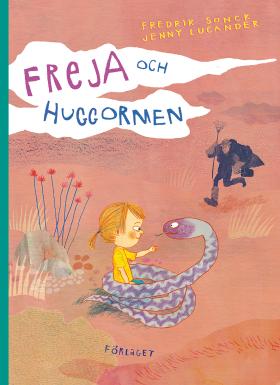
Freja och huggormen
(Freja and the Snake)
by Fredrik Sonck
illustrated by Jenny Lucander
reviewed by Elizabeth Lutz
When a poisonous snake shows up at the family’s cottage in the Åland Islands, Freja’s parents are concerned for her baby brother Hugo’s safety. Dad makes a valiant attempt to catch the snake, but after hours of trying to capture it alive, and gentle criticism from Mum, he decides that it has to be killed. He eventually bashes its head in with an oar. Freja witnesses the ‘murder’ (to her mind) and sees the dead snake lying exposed on the rocks. She is upset even when her mother and sister try to explain how dangerous this type of snake can be.
The story is narrated by Freja, the middle child of the three siblings. She immediately names the snake ‘Ormis’ (‘Snakey’) and stands up for it, even though it’s not cute: ‘Snakes aren’t cute like kittens or puppies or bunnies, but that’s not their fault, right?’ She wonders whether a whole bunch of snake babies are now missing their mother. Freja says a few words at the funeral they hold for the snake – to which her father is not invited. She even covers the snake with a blanket of flowers. It’s when Freja and her father row out together in the boat in the evening that they finally have a conversation about what happened. Dad admits that he could have done better.
The snake in the story is actually an adder, which is a protected species in Sweden and Finland. Freja’s older sister Julia says that in Åland you’re allowed to kill an adder when it’s on your own land. Although there are few cases of people dying from adder bites, Julia tells Freja about a little girl who had to be taken to hospital and nearly died. Considering that the book has so much to do with adders, it might have been beneficial to include a short section of factual information after the story. Some helpful things to know would be the season in which adders are most active, how to distinguish an adder from a grass snake, and how to relocate an adder—including who to contact if you need help capturing one. Perhaps a factual section could be added as end matter in a translation of this picture book.
Families will appreciate Sonck’s satisfying story that invites discussion about living in balance with other creatures on our planet. Freja’s love for the natural world definitely comes across as a theme. There’s something for parents to learn as well about admitting when they’re wrong. In Lucander’s illustrations, Freja is portrayed with a disproportionately large head, often making her the focal point and signalling her thoughtfulness. The colour choices are unexpected and playful, with purple appearing on the snake’s skin and blues mixed into the grass.

Freja och huggormen
Förlaget, Finland 2023
32 pages
Rights: Koja Agency (English rights sold)
Fredrik Sonck is a journalist and CEO at Åland’s Radio & TV. His debut, Freja och kråkungen (Freja and the Crow) was published in 2020. Freja och huggormen was nominated for the 2024 Nordic Council Children and Young People’s Literature Prize. Jenny Lucander lives in Helsinki. She has illustrated many books including När farmor flög (‘My Flying Grandma’) by Annika Sandelin (reviewed in SBR 2023:Finland-Swedish special issue) and Vi är lajon! (We Are Lions!) by Jens Mattsson, which won the 2020 Nordic Council Children and Young People’s Literature Prize and was published in BJ Woodstein’s translation by Groundwood Books in 2023.
